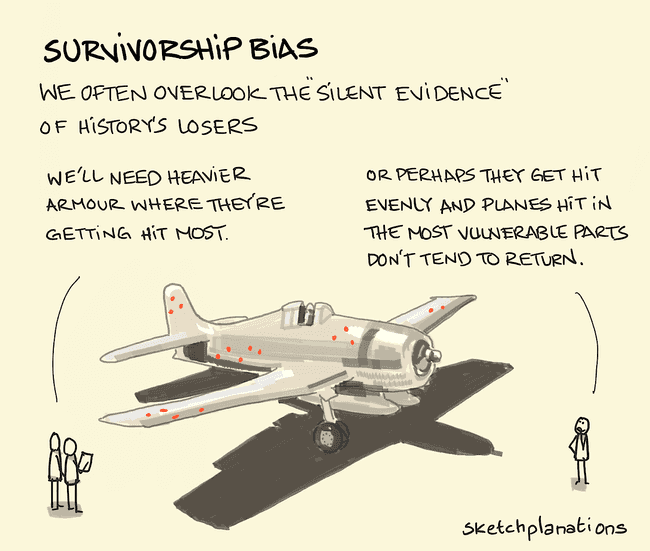Survivorship Bias
Survivorship Bias - Sketch Plantations
Survivorship bias or survival bias is the logical error of concentrating on the people or things that made it past some selection process and overlooking those that did not, typically because of their lack of visibility. This can lead to some false conclusions in several different ways. It is a form of selection bias.
Survivorship bias can lead to overly optimistic beliefs because failures are ignored, such as when companies that no longer exist are excluded from analyses of financial performance. It can also lead to the false belief that the successes in a group have some special property, rather than just coincidence (correlation "proves" causality). For example, if three of the five students with the best college grades went to the same high school, that can lead one to believe that the high school must offer an excellent education when, in fact, it may be just a much larger school instead. This can be better understood by looking at the grades of all the other students from that high school, not just the ones who made the top-five selection process.
Exapmle
In manufacturing and goods production
A commonly held opinion in many populations is that machinery, equipment, and goods manufactured in previous generations often is better built and lasts longer than similar contemporary items. (This perception is reflected in the common expression "They don't make 'em [them] like they used to"). Again, because of the selective pressures of time and use, it is inevitable that only those items that were built to last will have survived into the present day. Therefore, most of the old machinery still seen functioning well in the present day must have been built to a standard of quality necessary to survive. All of the machinery, equipment, and goods that have failed over the intervening years are no longer visible to the general population as they have been junked, scrapped, recycled, or otherwise disposed of.
In Military
During World War II, the statistician Abraham Wald took survivorship bias into his calculations when considering how to minimize bomber losses to enemy fire.[11] The Statistical Research Group (SRG) at Columbia University, which Wald was a part of, examined the damage done to aircraft that had returned from missions and recommended adding armor to the areas that showed the least damage, based on his reasoning. This contradicted the US military's conclusions that the most-hit areas of the plane needed additional armor.[12][13][14] Wald noted that the military only considered the aircraft that had survived their missions; any bombers that had been shot down or otherwise lost had logically also been rendered unavailable for assessment. The bullet holes in the returning aircraft, then, represented areas where a bomber could take damage and still fly well enough to return safely to base. Thus, Wald proposed that the Navy reinforce areas where the returning aircraft were unscathed, since those were the areas that, if hit, would cause the plane to be lost. His work is considered seminal in the then-nascent discipline of operational research.
Source : Survivorship Bias
Pic Credits : Sketch Plantations
